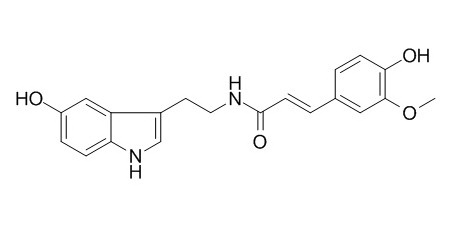Moschamine
Moschamine is a very potent compound that is able to inhibit COX-I by 58% and COX-II by 54%, at the concentration of 0.1 μmol L⁻1, it may suppress cAMP formation via binding to 5-HT1 receptors in the cells. Moschamine exerts antitumour effects on HeLa, MCF7 and A431 cells.
Inquire / Order:
manager@chemfaces.com
Technical Inquiries:
service@chemfaces.com
Tel:
+86-27-84237783
Fax:
+86-27-84254680
Address:
1 Building, No. 83, CheCheng Rd., Wuhan Economic and Technological Development Zone, Wuhan, Hubei 430056, PRC
Providing storage is as stated on the product vial and the vial is kept tightly sealed, the product can be stored for up to
24 months(2-8C).
Wherever possible, you should prepare and use solutions on the same day. However, if you need to make up stock solutions in advance, we recommend that you store the solution as aliquots in tightly sealed vials at -20C. Generally, these will be useable for up to two weeks. Before use, and prior to opening the vial we recommend that you allow your product to equilibrate to room temperature for at least 1 hour.
Need more advice on solubility, usage and handling? Please email to: service@chemfaces.com
The packaging of the product may have turned upside down during transportation, resulting in the natural compounds adhering to the neck or cap of the vial. take the vial out of its packaging and gently shake to let the compounds fall to the bottom of the vial. for liquid products, centrifuge at 200-500 RPM to gather the liquid at the bottom of the vial. try to avoid loss or contamination during handling.
Evid Based Complement Alternat Med.2021, 2021:8850744.
Chemistry of Plant Materials.2019, 129-136
Sci Rep. 2017, 8207(7)
Molecules.2021, 26(12):3652.
Plants (Basel).2023, 12(22):3877.
Current Analytical Chemistry2024, 20(8):599-610.
Chem Res Toxicol.2023, 36(2):213-229.
Curr Res Food Sci.2024, 9:100827.
J Appl Biol Chem.2022, 65(4):pp.463-469.
Drug Des Devel Ther.2023, 17:2461-2479.
Related and Featured Products
Phytother Res. 2010 Nov;24(11):1664-9.
Bioactivity-guided isolation of antiproliferative compounds from Centaurea arenaria.[Pubmed:
21031625 ]
METHODS AND RESULTS:
Flavonoids (eupatilin, eupatorin, 3'-methyleupatorin, apigenin and isokaempferid), lignans (arctigenin, arctiin and matairesinol), the sesquiterpene cnicin, serotonin conjugates (Moschamine and cis-Moschamine), β-amyrin and β-sitosterin-β-D-glycopyranoside, identified by means of UV, MS and NMR spectroscopy, were obtained for the first time from this species.
CONCLUSIONS:
The isolated compounds were also evaluated for their tumour cell growth inhibitory activities on HeLa, MCF7 and A431 cells, and different types of secondary metabolites were found to be responsible for the antitumour effects of the extracts; in addition to moderately active compounds (isokaempferid and Moschamine), especially apigenin, eupatorin, arctigenin, arctiin, matairesinol and cnicin exert marked antitumour effects against these cell lines.
Nat Prod Res. 2012;26(16):1465-72.
Synthesis, biological activities and bioavailability of moschamine, a safflomide-type phenylpropenoic acid amide found in Centaurea cyanus.[Pubmed:
21978225]
Moschamine is a phenylpropenoic acid amide found in plants. In this article, the synthesis and two biological activities (serotoninergic and cyclooxygenase (COX) inhibitory activities) and bioavailability of Moschamine were described.
METHODS AND RESULTS:
Moschamine was synthesised and confirmed using NMR spectroscopic methods. Using the Moschamine synthesised, serotoninergic and COX inhibitory activities were investigated. At the concentration of 10 µmol L⁻¹, Moschamine was able to inhibit forskolin-stimulated cAMP formation by 25% (p < 0.015), via inhibiting serotonin receptors in the OK cells.
CONCLUSIONS:
The inhibition was repressed by two 5-HT1 antagonists (Nan-190 and spiperone), suggesting that Moschamine may suppress cAMP formation via binding to 5-HT1 receptors in the cells. Also, Moschamine was a very potent compound that is able to inhibit COX-I by 58% (p < 0.012) and COX-II by 54% (p < 0.014), at the concentration of 0.1 µmol L⁻¹. The oral bioavailability of Moschamine was also determined in mice.



